

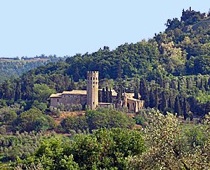
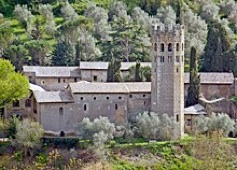
The abbey is dedicated to SS Severus and Martirius, who were mentioned in the Dialogues of Pope Gregory I as respectively a priest and a monk from Valeria (the Abruzzi). Local tradition has it that, when St Severus died at Antrodoco near Rieti in the 6th century, untamed oxen pulled the cart bearing his body to the outskirts of Orvieto. A noble lady called Rotruda tried to stop the cart here, and her hand stuck to the coffin until she agreed to donate land from her estate (near a church dedicated as San Silvestro) for the burial of the saint. The abbey presumably stands on the site on which, according to this tradition, St Severus was buried. There is evidence of a 6th or 7th century church on the site with the opposite orientation. [Architectural fragments embedded in the perimeter walls]
The complex passed to the Benedictines, who built a church and monastery here. An inscription on the altar frontal (ca. 700) in the Museo dell’ Opera del Duomo from the altar of the church (see below) records that Bishop Bishop Teuzone re-consecrated it in 1054, at the time of Abbot Giovanni. Pope Honorius III expelled the Benedictines in 1220 when they rebelled against the Bishop of Orvieto, and Premonstratensian canons replaced them. Until this time, the abbey was variously referred to as San Severo or SS Martirio e Maurizio. The saints were first explicitly linked together in a 13th century legendary known as the Codex Urbevetanus: the Premonstratensians could well have writted this codex as a foundation legend, and the dedication of the abbey as SS Severo e Martirio probably date to this time.
The possessions of the abbey at this point included Santa Lucia (later Sant’ Agostino).
The monks of SS Severo e Martirio had rights over the parish of San Martino. The friars of Santa Maria dei Servi bought land there in 1265, which brought conflict between the two communities. Pope Clement IV intervened to settle the dispute in the Servites’ favour.
Pope Martin V transferred the complex to the Olivetans in 1423, but they stayed for only a short while because they seem to have been resented by the people of the city. Pope Eugene IV passed it in commendum to Cardinal Pietro Barbo (the future Pope Paul II) in 1442, but he seems to have neglected it and it was in ruins by 1449.
A nearby Cistercian nunnery of San Bernardo (later the site of the Convento dei Cappuccini) served as the infirmary of the abbey in the 16th century.
The supposed relics of SS Severus and Martirius were moved in 1613, presumably for greater security, to Sant' Angelo, which was recorded as a possession of the abbey in 1297.
The abbey is now a hotel, La Badia di Orvieto.
Abbey Complex

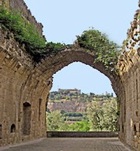
Crucifixion with the Virgin and saints (13th century)
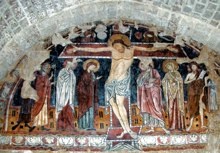
This fresco is in the old refectory (which is now the hotel restaurant). It depicts the Crucifixion with the Virgin and SS Severus (damaged), Augustine, Mary Magdalene, John the Evangelist, Elizabeth, John the Baptist and Martirius (destroyed).
Church
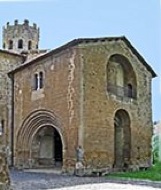
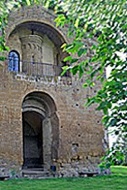
There is a fine arch on the north wall and a Gothic portal. A portico protects the east wall of the church, with the apse of the upper church in the arched recess above.
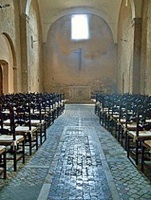
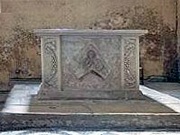
The church has a lovely Cosmatesque floor.
An inscription on the altar frontal (ca. 700) in the Museo dell’ Opera del Duomo from the altar of the church (see below) records that Bishop Bishop Teuzone re-consecrated it in 1054, at the time of Abbot Giovanni.
[Present altar?]
The first door in the left wall leads to a two-roomed oratory that probably acted as the sacristy (see below).
Upper Church
The second door leads to the upper church.
Crucifixion with the Virgin and saints (13th century)
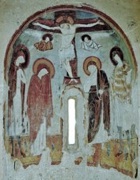
Sacristy
Madonna and Child enthroned with saints (late 13th century)
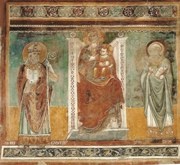
This fresco is attributed to a follower of the Maestro della Madonna di San Brizio. Inscriptions identify the saints as St Augustine (on the right) and St Severus.
SS Peter and Paul (13th century)
[Perhaps by a Roman artist]
Other Frescoes (14th or 15th century)
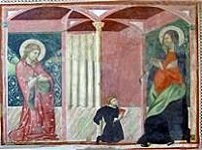

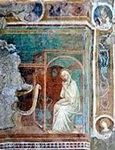
The sacristy contains a number of interesting frescoes, including:
-
✴the Annunciation with kneeling monk (presumably the donor);
-
✴St Christopher; and
-
✴the Virgin Annunciate (part of a second fresco of the Annunciation).
Art from the Complex
Altar frontal (ca. 700)
An inscription on this frontal from the original high altar of the church records that Bishop Teuzone re-consecrated it in 1054, at the time of Abbot Giovanni. It is now in the Museo dell' Opera del Duomo [not displayed??].
Two Apostles (ca. 1280)
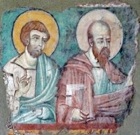
Madonna and Child enthroned (ca. 1300)
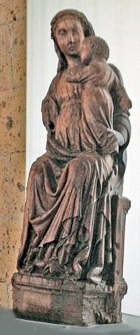
Components of a Pulpit (perhaps 6th century)
The pulpit in Sant’ Andrea is composed of reliefs from a pavement that is sometimes said to have been in SS Severo e Martirio, although any evidence for this no longer survives.

